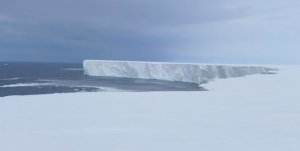According to a new study, a vital section of the world’s largest ice shelf is losing ice 10 times faster than the overall melt rate for the structure, posing a potential risk to its future stability. The Ross Ice Shelf stretches out over 500,809 km2 (193,363 miles2), and accounts for 32 percent of Antarctica’s total ice shelf area.
Antarctica’s ice shelves are known to play a vital role in mitigating rising sea levels, however, they do not do so directly. Whilst ice shelves are always connected to a landmass, their vast frozen bulk is actually afloat in the ocean. Because of this, even when a significantly-sized chunk of a shelf breaks off, drops into the ocean and melts, it does not contribute to the rise in sea level, as the mass that formed the fragment was already displacing the water.
Their ability to slow the rise in global sea-level stems from their ability to slow the flow rate of the ice streams and glaciers that feed them. Think of an ice shelf as a stopper. If one were to fully break apart and disappear, the material flowing from the glaciers behind it would flow directly into the ocean.
Read more HERE
Ask me anything
Explore related questions





